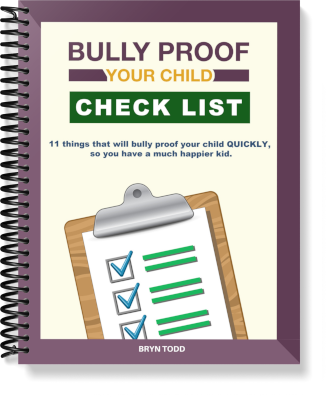
If your child is being bullied, you must respond immediately to ensure they feel safe and supported. Bullying can harm a child’s happiness and affect their mental health, so you must address the issue as quickly as you can.
Your child may need to learn some new key skills like how to be more assertive, discover ways to shut down teasing, and how to show up with confidence. Learning news skills and making your home a pleasant, supportive environment will empower your child and make it less likely that bullying will persist.
Let’s clarify what bullying actually is
Bullying happens when someone intentionally acts cruelly to another person when there is a power imbalance. It can manifest itself in a variety of ways, such as hitting, speaking hurtful things, or interfering with friendships.
Here’s the truth: kids who are bullied are miserable. It doesn’t just make people unhappy; it can also make them anxious, and depressed, and can cause headaches or stomach issues. And the bottom line is bullying is not OK, it is not normal, and we should never ignore it.
Here are 11 quick ways parents may help their child become bully-proof.
1. Teach your child to identify bullying behavior
A smart option is to educate your child on the many types of bullying. There’s the physical game, such as striking or kicking, the verbal game, such as name-calling or mocking, and the social scene, where friendships are strained. Knowing what goes on allows your child to keep one step ahead of the game.
Isolation, spreading rumors, and tarnishing someone’s reputation are all examples of social bullying. However, in our digital age, cyberbullying is a new player on the field that is creating waves. Remain vigilant and keep your kids informed about it.
Cyberbullying is defined as the use of technology to harass or intimidate someone, whether through harsh messages or mean remarks on social media. Keep an eye out for these bullying behaviors and take action to stop them.
2. Show your child How to stay safe at school
As a parent, your primary concern is your child’s safety at school. Schools can be a breeding ground for this type of behavior. However, there are steps you can take to ensure your child’s safety at school:

Are there any areas in the school without supervision your child should stay away from?
It is essential to teach your child about places at the school that may be unsupervised. Encourage children to avoid places like vacant halls, isolated corners, and rarely used restrooms. If there are specific areas of concern, openly discuss them with your child and the school personnel to ensure that everyone is on the same page about safety standards.
Help your child develop a safety plan
Create a specific safety plan with your child to prepare them. Begin by encouraging open dialogue about their issues and identifying reliable persons at school and in the community. Discuss safe routes, emergency contacts, and the buddy system, emphasizing the significance of following safety paths.
3. Teach your child that bullies are trying to trigger them
Bullies frequently strive to annoy their victims by saying or doing things they know will irritate them. It is critical to tell your child that this is a planned strategy. They should not allow the bullies to win and see them get really upset. Here are some suggestions for teaching your child how to deal with bullies:
Teach your child the power of no reaction when dealing with a bully. When a bully tries to get under their skin, teach them how remaining calm and collected is a heroic move. Encourage them to take calm breaths, count to ten, and remember that bullies are looking for a reaction. And if they do not find one, they will lose interest and move on.
Another effective technique to cope with bullies is to play out scenarios with your children. Try acting out different but plausible scenarios in which bullies try to provoke your children but they remain calm. This will boost their confidence and prepare them for real-life events.
You prepare your children for potential situations by teaching them how bullies are simply attempting to provoke them to feed on their reactions. In this manner, you can help your child in dealing with bullies as quickly as possible.
4. Verbal Self-defense
Bully-proofing your child entails training them with verbal defense tactics for dealing with bullies. Encourage your child to keep eye contact and stand tall. Bullies frequently target individuals who look to be vulnerable and won’t respond to teasing.
Teach them to walk with purpose and to exude confidence through their body language. Furthermore, advise your child to address the bully in a calm and firm tone. Make them avoid using anger or animosity that can escalate the situation.
Educating your child in verbal self-defense is an important skill that will benefit them for the rest of their lives. When your child learns to handle teasing confidently, he or she is less likely to be targeted by bullies.
5. Make sure your child Isn’t an easy target
As a parent, you want to keep your child safe from bullies, right? One wise decision is to ensure that your child is not an easy target. Here’s what to remember:
Does your child have a behavior that may make them a target?
Keep an eye out for behaviors that may make your child a target for bullies. For example, if they are quiet or new to a town, bullies may regard them as easy targets. The same is true whether they have a physical difference, such as glasses or a disability. It’s just a good idea to be aware of them and keep an eye out for them.
If you notice any of these signs in your child, act immediately. Get your kids interested in joining things, making friends, and feeling good about themselves. And, if there’s a physical issue, consult with their teacher or counselor to make any necessary adjustments.
More posts you might like
- What nobody ever tells parents about bullying
- 7 Ways to boost your child’s confidence quickly
- Why won’t parents admit their child is a bully
6. Prepare your child for potential Situations
Bullying can occur anytime. Being prepared is the greatest approach to dealing with it. Here are a few pointers to get you started:
If you know a mean girl will exclude your daughter at lunch, have a plan B of who she can sit with if it happens
Children rely on friendships a lot, and feeling excluded may be devastating for them. If your child is concerned about being rejected from her group, make an alternative plan. Remind them about their other friends with whom they can socialize. Make them understand that being alone can be good at times. Also, teach kids to seek out and establish new acquaintances.
7. Teach your child how to make new friends
Educating your kids on how to make friends is an essential social skill. It’s a great idea to encourage them to politely introduce themselves and extend a warm greeting. In this way, they show to others that they are friendly and ready to make new acquaintances.

One of the most important social skills that kids may learn is asking to join a game or activity, but timing is essential. It’s vital to teach kids the value of waiting for a natural pause in the activity or, even better, asking ahead of time if they can participate so that they avoid disrupting the flow and demonstrate respect for others in this manner. Mastering these social variables not only boosts their confidence but also promotes social awareness, laying the groundwork for productive connections and gaining new friends.
8. Help your child build strong friendships
A strong circle of friends can be an effective protection against bullies. Here are some strategies to encourage your child to form excellent peer relationships:
Developing solid friendships and social skills is an effective method for helping your child become bully-proof. When children have a supporting network of friends, it not only improves their social well-being but also acts as a barrier against bullying.
Participating in team-based activities is an excellent method to develop social skills and provide an opportunity for your child to build friendships with like-minded classmates. Joining a sports team, a club, or a music group, for example, provides a supportive atmosphere for developing confidence and interacting with others who share similar interests.
Are there any friendship skills your child needs to work on?
Building strong relationships gives your child the tools he needs to deal with social situations with confidence and resilience. Friends encourage them, knowing, and a sense of belonging, all of which add to their general well-being.
Teaching your child to recognize bullying tendencies gives them the ability to stay safe and confident in any environment. They may reply assertively and seek support when they are aware of these behaviors, building a strong sense of self-assurance.
9. Teach your child to be assertive
Assertiveness is an important quality that will enable your child to speak up for themselves and prevent bullying. Here are some suggestions for teaching your child to be assertive:
Set Boundaries
Establishing and adhering to boundaries is an important life skill to teach your child. If they are mocked, encourage them to voice their feelings assertively, such as “I don’t like it when you tease me, and I want you to stop.” This not only expresses their discomfort but also defines a clear barrier.
An excellent approach to giving your child the opportunity to act aggressively in a safe environment is through role-playing. You can give your kids practice developing and honing their assertive reactions by role-playing situations in which they might be bullied. For example, helping your child to assertively state, “That’s my toy, and I want it back now,” if a bully takes their possession is a great way to empower them.
Teaching assertiveness is a journey that takes time and requires patience as well as constant practice. By implementing these suggestions into your parenting style, you are creating the groundwork for your child to gain confidence and effectively advocate for themselves.
10. Teach your child conflict resolution
In relationships, disagreement is unavoidable, and teaching your child how to negotiate and resolve conflicts healthily and politely is an important life skill.
Fostering friendships and social skills is a great strategy for helping your child become resilient and confident, establishing a natural barrier against bullying. Encourage your child to join in extracurricular activities, promote open communication, and teach them conflict resolution skills. Not only will these tools improve their social interactions, but they will also lay the framework for persistence and healthy relationships.

Conflict resolution is an inherent aspect of any relationship, and teaching your child healthy conflict resolution skills is critical. Encourage children to resolve differences calmly and politely, emphasizing the need for open communication. Additionally, let children know that it is acceptable to seek assistance from someone they trust when necessary.
11. Teach your child how to be resilient
Resilience is an important life characteristic that enables kids to overcome obstacles and recover from unfortunate circumstances. Here are some pointers to help teach your child resilience:
Foster Independence: Teach your child to take on responsibility and make age-appropriate decisions. This not only increases their independence but also their trust and faith in their abilities.
Teach Problem-Solving Skills: Educate your kid on how to tackle difficulties logically. Developing effective problem-solving abilities allows students to efficiently manage problems.
Building your child’s independence is a continual and evolving process that takes time. It’s a journey of progress and growth, and your advice and support will be essential.



